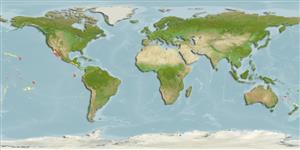Elasmobranchii (sharks and rays) >
Carcharhiniformes (Ground sharks) >
Triakidae (Houndsharks) > Triakinae
Etymology: Mustelus: Latin for weasel, an ancient name for sharks, possibly referring to the pointed snouts, swift movements and/or rapacious feeding behavior of smaller predatory sharks [strictly not tautonymous with Squalus mustelus Linnaeus 1758 since type was designated by the ICZN] (See ETYFish); albipinnis: albus (L.), white; pinnis (L.), fins, referring to white margin around dorsal, pectoral, pelvic and anal fins (See ETYFish).
Environment: milieu / climate zone / depth range / distribution range
Ecology
Marine; benthopelagic; depth range 30 - 281 m (Ref. 30948). Tropical
Eastern Pacific: Gulf of California.
Size / Weight / Age
Maturity: Lm ? range ? - ? cm
Max length : 109 cm TL male/unsexed; (Ref. 30948); 118.0 cm TL (female)
Short description
Identification keys | Morphology | Morphometrics
Description of Mustelus hacat: this species differs from its congeners in having a uniformly dark gray brown color above and conspicuously having white tips and trailing edges of the dorsal, pectoral, anal, and caudal fins. Although some specimens of M. lunulatus and newborn pups and juveniles of M. canis from the western Atlantic, have tips and trailing edges of first dorsal, pectoral, anal, and caudal fins transparent or pale white, they clearly differ from this species in having less contrasted dorsal color compared with tips and trailing edges of the fins. Mustelus hacat is distinguished from the other eastern North Pacific species of Mustelus in having: 1) upper jaw teeth cuspidate and distinctly asymmetric, with low rounded cusp (teeth of californicus and lunulatus are from molariform to cuspidate and slightly asymmetric, with blunt to low rounded cusp, whereas henlei
and dorsalis have cuspidate and slightly asymmetric, with high sharp cusp teeth); 2) upper jaw labial folds notably longer than the lower folds, only similar to henlei (californicus has upper and lower jaw labial folds about equal in length, lunulatus has upper jaw labial folds notably shorter than lower jaw labial folds, and dorsalis has upper jaw labial folds slightly longer than lower jaw labial folds); 3) posterior margin of first dorsal fin vertical from apex, only similar to lunulatus, californicus, henlei, and dorsalis have the first dorsal fin with sloping posterior margin); 4) inter-nostril space wide (49-58 vs. 33-49% pre-oral length for all other four species); and 5) inter-orbital space wide (5.6-6.8 vs. 4.3-5.6% TL for californicus, henlei, lunulatus, but similar to dorsalis 5.7-7.5% TL) (Ref. 30948).
Information for Mustelus hacat include mode of reproduction is placental viviparity, having a brood size of 3 to 23 (mean 16); embryo measures 25-34 cm TL (mean 29 cm); young born probably between 30-35 cm TL; females mature between 94-98 cm and males between 90-99 cm TL. Caught by trawlers (Ref. 30948).
Life cycle and mating behavior
Maturity | Reproduction | Spawning | Eggs | Fecundity | Larvae
Castro-Aguirre, J.L., A. Antuna-Mendiola, A.F. González-Acosta and J. De la Cruz-Agüero, 2005. Mustelus albipinnis sp. Nov. (Chondrichthyes: Carcharhiniformes: Triakidae) from the southwestern coast of Baja California Sur, México. Hidrobiológica 15(2):123-130. (Ref. 91262)
IUCN Red List Status (Ref. 130435: Version 2024-1)
Threat to humans
Harmless
Human uses
Fisheries: bycatch
Tools
Special reports
Download XML
Internet sources
Estimates based on models
Preferred temperature (Ref.
123201): 12.6 - 20.1, mean 15.3 °C (based on 41 cells).
Phylogenetic diversity index (Ref.
82804): PD
50 = 0.5000 [Uniqueness, from 0.5 = low to 2.0 = high].
Bayesian length-weight: a=0.00224 (0.00104 - 0.00482), b=3.14 (2.97 - 3.31), in cm total length, based on LWR estimates for this Genus-body shape (Ref.
93245).
Trophic level (Ref.
69278): 3.6 ±0.4 se; based on size and trophs of closest relatives
Resilience (Ref.
120179): Medium, minimum population doubling time 1.4 - 4.4 years (Preliminary K or Fecundity.).
Fishing Vulnerability (Ref.
59153): High to very high vulnerability (71 of 100).
Nutrients (Ref.
124155): Calcium = 19.9 [5.8, 106.3] mg/100g; Iron = 0.373 [0.105, 1.367] mg/100g; Protein = 20.3 [18.0, 22.7] %; Omega3 = 0.0904 [, ] g/100g; Selenium = 96.1 [27.3, 382.5] μg/100g; VitaminA = 18.1 [5.9, 54.2] μg/100g; Zinc = 0.985 [0.423, 2.081] mg/100g (wet weight);
